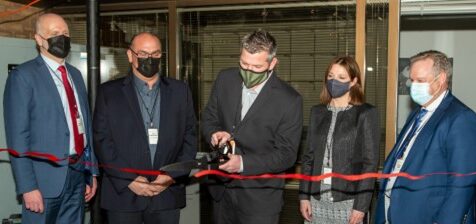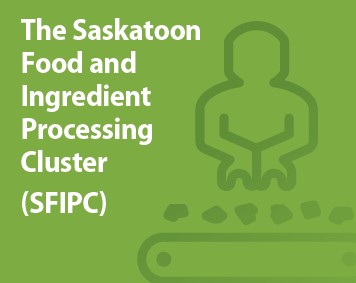Since the launch of the Global Agri-Food Advancement Partnership (GAAP) in December 2021, the stakes have become higher and the opportunities have become greater for agri-food in Saskatchewan. Global events have highlighted the impact of political instability, supply chain issues and climate change on food security.
Businesses around the globe are looking for a stable place to land. It’s a chance for Canada—and Saskatchewan—to shine. The agri-food ecosystem in Saskatchewan is moving quickly on networking, innovation and infrastructure development to not only feed the world, but also to sustainably supply
the world with innovative agri-food products.
Ag-West Bio President and CEO Karen Churchill says, “An ecosystem is a complex network or interconnected system. For it to be successful, it needs to have political stability, economic growth, a talent pool, and sector strength, as well as financial incentives, including investment dollars and a supportive tax structure.” By tending each of these areas, the GAAP partners are building a resilient and sustainable ecosystem that can weather any storm.
Nurturing networks
Strengthening existing networks and establishing new ones has been a focus.
Ag-West Bio has been supporting the establishment of the Saskatoon Food & Ingredient Processing Cluster (SFIPC). Issues related to the sector are presented at networking events where entrepreneurs, investors and government organizations meet, discuss challenges, and find synergies.
Churchill says, “In many ways our ecosystem is very mature, particularly related to production and research capability. But in other ways, the ecosystem is still nascent. To be competitive, we must continue to adapt. We’re working to fill a pipeline with ideas and businesses, get them to a place that is ‘commercial ready’ and send them further along the pipeline to becoming successful. We’re building ‘watering holes’ around various topics, like fermentation or biodiesel.”
Blair Knippel, who co-chairs SFIPC with Churchill, says, “We are at the stage of creating an effective, strong network and are expanding quite quickly with new members every month. Members are making network contacts by attending meetings and working directly with Joanne Baczuk, Director of Ecosystem Development. Saskatoon will ultimately have a stronger economy and a more cost effective and resilient food and ingredient processing cluster because of those interconnections.”
These networks expand beyond Saskatoon’s city limits. Economic Development Regina recently launched the Agriculture and Food Innovation Strategy for the Greater Regina Area, and Ag-West Bio opened a Regina office. Penny McCall, Assistant Deputy Minister for Regulatory and Innovation at the Ministry of Agriculture says, “It’s exciting that these incubation spaces are expanding into Regina. Having this space in Regina will help Ag-West Bio better serve the southern part of the province.”
As entrepreneurial networks are connecting, other cluster members are focusing on building a skilled agri-food workforce. Mehmet Tulbek has just taken the reins of the Saskatchewan Food Industry Development Centre (Food Centre) and is overseeing a shift into capacity building on the human resource development and training front. “We need to be in a position to train 500 to 1000 staff to fill new positions in the new plants opening in Saskatchewan in the next three to five years,” he says. With programs targeting Indigenous youth and new Canadians, they’re tapping into potential talent pools, drawing talent to Saskatchewan, and keeping it here to support a growing value-added industry.
Fostering innovation
The innovation landscape in Saskatchewan has shifted slightly in the direction of streamlining and stabilizing the mix of funding, infrastructure and collaboration that supports start-ups.
The Saskatchewan Government announced in March that Innovation Place will be under the ownership of Innovation Saskatchewan. Kari Harvey, CEO of Innovation Saskatchewan, says, “There are a lot of synergies between the two organizations. We have joint stakeholders and clients, but we support them in complementary ways. Working together more deliberately, we can drive government’s priorities in the innovation space.”
“The most interesting opportunity is on the investment attraction side. We can amplify the story of our innovation ecosystem across Canada and internationally. The province is opening international offices. This package, in terms of research funding, the opportunityto be part of an innovation hub, and the ag-tech hub at the Innovation Place campus, has already attracted international attention.” Harvey cites Israeli genotyping company, NRGene, which selected Saskatoon as its North American office location in 2020.
For the GAAP founding partners, the sense of urgency is still palpable. As an agriculture innovation catalyst, the Global Institute for Food Security (GIFS) continues to connect the agri-food ecosystem, advance innovation and bridge the gap to commercialization to deliver resilient and sustainable food security for all stakeholders.
GIFS’ CEO Steven Webb says, “We can’t afford to tackle today and tomorrow’s challenges with yesterday’s tools and technologies. This means that research should be applicable to the challenges, with a view to addressing needs and meeting market demand. Discovery and applied research, as well as commercialization in agriculture and food sectors, help us take successful innovations to market to enable Canada to fulfill its moral obligation to feed the world sustainably.”
GAAP offers the opportunity of a two-way exchange of information: getting our innovations out to the world, but also bringing global innovation to the province. Churchill says not every problem has to be solved at home. “GAAP is also able to bring innovations from around the world to serve the needs of Canadian producers and businesses. It’s a different but important angle that will help grow the ag sector. Often there has been a lot of time and money spent on a problem elsewhere that we can adapt to our type of agriculture for a win, especially in our growth areas, such as the value-added field.”
Building the infrastructure
While the intangibles like collaboration are critical, success is impossible without tangible funding dollars committed to innovation, and physical infrastructure is also needed, both on small and large scales. SFIPC hopes to connect entrepreneurs with similar needs to create efficiencies. “For example, we’re looking at shared ownership models for critical pieces of infrastructure for smaller scale processors,” says Knippel.
Infrastructure is important at both the R&D and commercialization phases. Webb says, “GIFS has developed research infrastructure and state-of-the-art equipment that takes the burden of capital investment off ag-tech companies and start-ups, knowing our facilities exist here in Saskatoon.”
Tulbek gives a nod to the five proposed new canola crush plants announced for Saskatchewan. “We need to increase not only canola crushing capacity but also pulse processing and fractionation capacity. We need to find space to utilize co-products for fermentation. The Food Centre is expanding 7,800 square feet to create an Advanced Food Ingredient Centre specializing in fermentation.” The goal is to attract companies to set up in Saskatchewan, using local infrastructure, a local workforce and locally grown raw materials.
Aiming for sustainability
The layers of sustainability in the evolution of the ecosystem are many: research into sustainable production solutions; creating value out of what used to be considered waste; telling the story of the environmental benefits of Saskatchewan agriculture; building a stable and prosperous ecosystem that is vital and resilient—and feeding the world at the same time.
Tulbek says, “It’s obvious, with what we’re experiencing now with the changing world order in the post-Covid food system, that food will become more precious. We need to utilize our commodities and products more efficiently and the world will be looking more and more to Canada and Saskatchewan. We need to sustain and bolster this growth to really maximize our opportunities. Sustainability supports all our activities—it will be our nucleus of growth. We want to help all the organizations grow together. We need to work closely with stakeholders, local groups, government, clusters, universities, and the entire, overall industry.”
The GAAP founders believe that consistent government support is key to that sustainable development.
McCall agrees: “We’re on a firm path forward. We’re very clear on our direction and committed to staying the course. We provide consistent and effective policies and programs. 2021 was Saskatchewan’s highest export value year, ever. We’re on the right path. Our trifecta of strength in the agri-food sector is the quantity, quality and diversity of what Saskatchewan produces, the research and innovation to make those crops more profitable, and the people, including Ag-West Bio, with the vision to make it happen.”
Churchill affirms a two-fold approach to this sustainable development—nurturing the ecosystem at home, while building relationships abroad. “We’ll be continuing with our collaboration and moving beyond what we can grow, regarding ideas in Saskatchewan. We continue to echo that ‘innovation is a team sport’ and we are privileged to have a strong team that genuinely believes in growing the agri-food ecosystem.”

